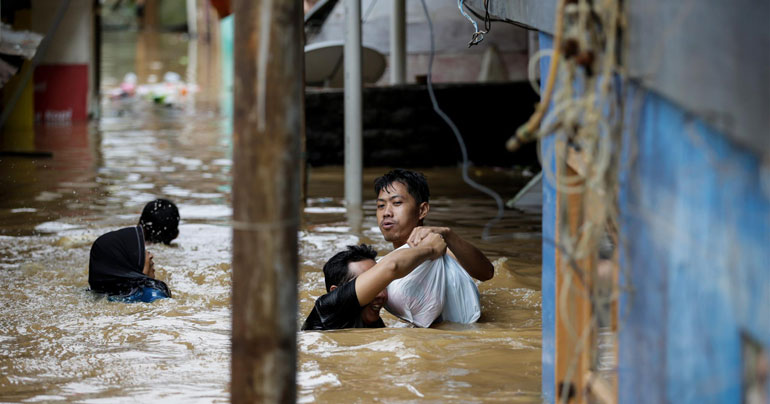Southeast Asia is likely to see an increase in flooding for the next several decades that could dampen economic growth, increase levels of poverty and leave more people at risk of potentially deadly disease, according to information gathered by the United Nations (UN), the Asian Development Bank (ADB) and the World Bank.
The United Nations’ Intergovernmental Panel on Climate Change (IPCC) published a report last week that predicted a bleak future for the world and for Southeast Asia in particular: as temperatures continue to rise as a result of climate change, the UN predicts increased incidences of flooding in the region through the year 2040.
Average temperatures in Southeast Asia have been on the rise since the 1960s, and according to the Global Climate Risk Index, four of the region’s countries – Vietnam, Myanmar, the Philippines, and Thailand – are among the top ten nations that have been most negatively impacted by climate change in the past 20 years.
This trend is expected to continue as the UN report stated with “high confidence” that Southeast Asia is very likely to undergo several “extreme climate events” in the near future that will see massive flooding in Indonesia, the Philippines, and Vietnam. Countries including Malaysia, it warned, may eventually be forced to rapidly evacuate as a result of frequent devastating natural disasters.
As the threat of persistent flooding rises, so too does the threat of disease associated with high water and lack of shelter, including mosquito-spread diseases like dengue fever and malaria.
The economics of climate change
One of the key messages of the report is not only that the region should see increased natural disasters in several years’ time, but rather that Southeast Asia is “already seeing the immense consequences of global warming”, according to IPCC working group co-chair Panmao Zhai.
Southeast Asia is no stranger to extreme weather and the consequences that come with it. Flooding in Laos, Vietnam and Myanmar have persisted throughout the year, while typhoons and tsunamis of extraordinary strength have wreaked havoc in the Philippines and Indonesia. And as cities in the region become more populated, death tolls from each natural disaster continue to climb.
“You have to unravel the impact of climate change, which is certainly there, on economic development and population growth,” Marcel Marchand, a Hanoi-based expert in flood risk management, told a local news outlet regarding recent flooding in the region.
“The impact of a flood or storm is now generally more than in the past,” he added. “That is not only because there are more hazards, or because hazards are more severe, but also because there are more people, and cities are becoming bigger.”
The economic impact from these repeated disasters could be devastating, as key sectors including agriculture, tourism, and fishing take massive hits. Increasingly warm temperatures could destroy rice crops in Indonesia, the Philippines, Thailand and Vietnam, lowering overall rice yield by 50% come the end of the century, according to a 2017 study released by the ADB.
And even as the World Bank maintains a relatively positive view on near-term economic growth across much of Southeast Asia, its recent annual report on the region noted that its primary concern is the possible persistence of widespread flooding – and several countries’ inability to shoulder the economic burden of disaster relief and eventual rebuilding.
Two countries whose economies could be most affected by extreme weather in the very near future, according to the World Bank, are Laos and Myanmar. In Laos, excessive flooding has brought down agricultural output significantly, and as the country attempts to bounce back it faces growing debt as a result of limited domestic revenue and rising payments for disaster relief efforts.
The seasonal flooding in Myanmar saw more than 120,000 people displaced from their homes by the end of July this year, and as families desert their drowned crops, food prices have continued to rise. The World Bank estimates that inflation in the country is likely to accelerate through next year, especially as Myanmar sees reduced international assistance in the face of the ongoing Rakhine crisis.
Preparing for the future
As climate change persists, experts urge that it is imperative for Southeast Asian governments to prepare themselves for the inclement weather on the horizon.
“Factors including continued high emissions will increase risks for Southeast Asia,” said Purnamita Dasgupta, a lead author of the IPCC report. “Key issues range from coastal and river flooding, with the potential for widespread damage, to heat-related mortality, to water and food shortages.”
She added, however, that a “wide diversity of adaptation options” could help to reduce these risks, including limiting greenhouse gas emissions, increasing efforts to retain coastlines, and preparing at-risk communities with guidelines for effectively managing future disasters.
“Climate change is perhaps the single greatest challenge confronting the Asia-Pacific region and its more than 4 billion people,” said Shamshad Akhtar, UN undersecretary general, at a recent meeting on the IPCC report results. “We must utilise the full potential of regional cooperation, as well as cutting-edge science, technology, and innovation, to accelerate our progress.”


